V-1: Difference between revisions
Pbcjohnston (talk | contribs) Added photos |
Pbcjohnston (talk | contribs) Finished adding photos |
||
| Line 58: | Line 58: | ||
[[File:Barracuda Washington Navy Yard-1.jpg|left|500px]] | [[File:Barracuda Washington Navy Yard-1.jpg|left|500px]] | ||
<div style="text-align: justify;"><span style="color:#00008B">A third view of the | <div style="text-align: justify;"><span style="color:#00008B">A third view of the V-1 and although it is dated the same as the two photos above the lack of the ship in the background indicates that it was likely taken several hours after the other two. | ||
<small>U.S. Navy photo</small> | <small>U.S. Navy photo</small> | ||
| Line 73: | Line 73: | ||
[[File:Barracuda block island 1-1925.jpg|left|500px]] | [[File:Barracuda block island 1-1925.jpg|left|500px]] | ||
<div style="text-align: justify;"><span style="color:#00008B">V-1 running close ashore to Block Island, approximately January, 1925. The trees are bare and there is lots of ice slurry on the calm waters. This shakedown cruise was intended to fully test the Busch-Sulzer 6M375 diesel engines and would range as far as the Caribbean. She did not return to Portsmouth until the end of May. | <div style="text-align: justify;"><span style="color:#00008B">V-1 running close ashore to Block Island, approximately January, 1925. The trees are bare and there is lots of ice slurry on the calm waters. This shakedown cruise was intended to fully test the Busch-Sulzer 6M375 diesel engines and would range as far as the Caribbean. She did not return to Portsmouth until the end of May. | ||
All three of her radio masts are lowered, indicating that she has just surfaced or is preparing to dive, although either maneuver would be dangerous this close to land. | |||
<small>National Archives photo</small> | <small>National Archives photo</small> | ||
| Line 82: | Line 84: | ||
One of the two ship's boats, stowed under the deck just aft of the conning tower fairwater when not in use, can be seen moored alongside. Forward of the conning tower can be seen a folding set of steps to allow access to the submarine from a small boat. These were folded back into the superstructure when not needed. | One of the two ship's boats, stowed under the deck just aft of the conning tower fairwater when not in use, can be seen moored alongside. Forward of the conning tower can be seen a folding set of steps to allow access to the submarine from a small boat. These were folded back into the superstructure when not needed. | ||
<small>Photo in the private collection of Ric Hedman.</small> | |||
[[File:Red bar sub new.jpg]] | |||
[[File:Barracuda Panama canal.jpg|left|500px]] | |||
<div style="text-align: justify;"><span style="color:#00008B">V-1 transiting the Gaillard Cut in the Panama Canal, November, 1927. The steep sides of the cut in these early days are evident in this photo. | |||
<small>Photo in the private collection of Ric Hedman.</small> | <small>Photo in the private collection of Ric Hedman.</small> | ||
| Line 101: | Line 110: | ||
[[File:Red bar sub new.jpg]] | [[File:Red bar sub new.jpg]] | ||
[[File:Barracuda pearl harbor1928-1.jpg|left|500px]] | |||
<div style="text-align: justify;"><span style="color:#00008B">The crew of the V-1 photographed at Pearl Harbor sometime between the end of April, 1928 and mid-June, 1928. She came to Hawaii to take part in Fleet Problem VIII, an exercise that pitted light cruisers and a detachment of ships from Pearl Harbor ("Orange") against the Battle Fleet and the supply Train ("Blue"). The Submarine Division 20 tender seen alongside is the USS Argonne (AS-10). | |||
In the photo the fourth man from the left, second row from the top, is Herman S. 'Brigham' Young, grandfather of Johanna Young who submitted this photo. | |||
The barrel of the V-1's 5"/51 caliber deck gun is pointed to the right in the photo to make room for all the men to be positioned at the widest point on the deck. The top man on the right is leaning on the barrel. | |||
<small>Original photo in the family collection of Johanna Young. MAY NOT BE REUSED OR REPOSTED WITHOUT PERMISSION.</small> | |||
[[File:Red bar sub new.jpg]] | |||
[[File:barracuda juneau-1.jpg|left|500px]] | |||
<div style="text-align: justify;"><span style="color:#00008B">V-1 was renamed Barracuda on February 19, 1931 and a few months later was redesignated SS-163. The summer of 1934 had her and her sisters conducting a cruise to Alaska, and Barracuda is seen here anchored in Juneau, July, 1934. By this time her deck gun had been changed out for a 3"/50 caliber Mk 17 gun. The lighter weight weapon helped to improve stability problems of the class. | |||
<small>Photo in the private collection of Ric Hedman.</small> | |||
[[File:Red bar sub new.jpg]] | |||
[[File:Barracuda juneau-2.jpg|left|500px]] | |||
<div style="text-align: justify;"><span style="color:#00008B">Barracuda is moored to one of her sisters in an Alaskan port, summer of 1934. Submarine Squadron 12 made its famous Alaska cruise with the submarine tender USS Holland (AS-3) herding "all her chicks" on the epic voyage testing long distance abilities of the fleet. | |||
<small>Photo in the private collection of Ric Hedman.</small> | |||
[[File:Red bar sub new.jpg]] | |||
[[File:Barracuda WWII.jpg|left|500px]] | |||
<div style="text-align: justify;"><span style="color:#00008B">Barracuda underway in an unknown location, approximately 1942-1943. This is likely before the conversion to a cargo configuration. The boat had been repainted flat black back in 1935 and her hull number replaced the B1 class identifier in 1939. | |||
<small>U.S. Navy photo</small> | |||
[[File:Red bar sub new.jpg]] | |||
<center>[[V-1 Class|Return to the V-1 Class Page]] | [[V-class|Return to the V-class page]]</center> | <center>[[V-1 Class|Return to the V-1 Class Page]] | [[V-class|Return to the V-class page]]</center> | ||
[[File:Red bar sub new.jpg]] | [[File:Red bar sub new.jpg]] | ||
Revision as of 16:30, 2 July 2023
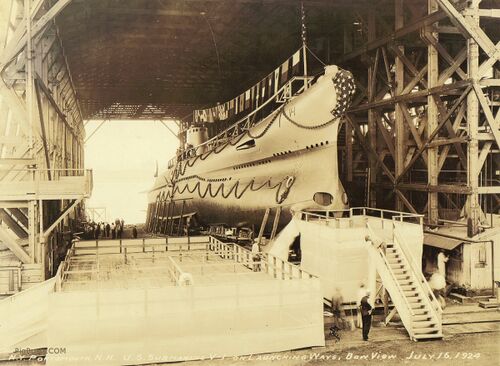
This is a good look of the bow torpedo tube outer doors. Unlike subsequent practice, they do not smoothly fare into the outer hull. The pressure hull was a complex of various angles and diameters bringing the torpedo tubes to the hull's lowest point. The hull was a variety of shapes from circular to ellipses, making the construction a nightmare for the shipyard.
U.S. Navy photo

A large brace has been attached to the shaft struts and clamps together, over the top of the stern planes and aft of the rudder. This is to prevent damage to the rudder and stern planes as the submarine slides backwards into the water. Just above the rudder the two aft torpedo tubes can be seen.
U.S. Navy photo
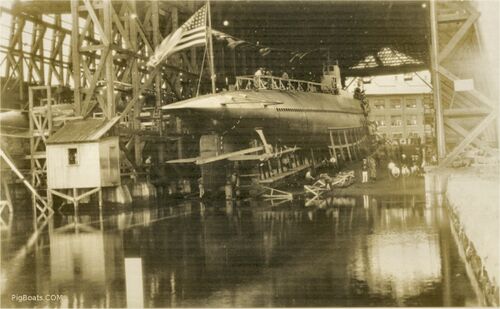
At the left in the photo, what is probably the V-2 sits on the ways. Just the slope of her stern, matching the V-1 stern, can be seen.
Photo in the private collection of Ric Hedman.
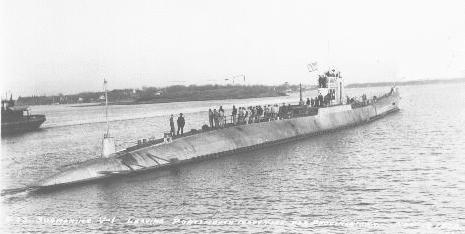
U.S. Navy photo

U.S. Navy photo
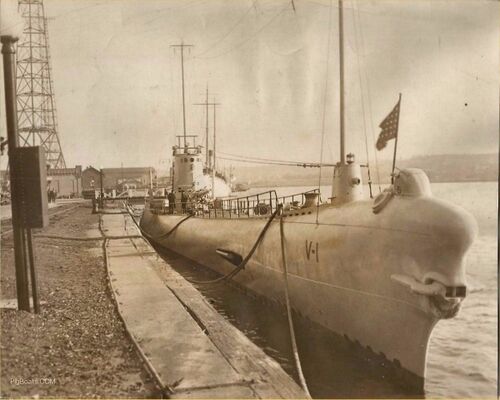
U.S. Navy photo

There is an unidentified yacht like ship in the background, possibly the Presidential yacht, Mayflower. The Mayflower had her small boats stowed on highly raised davits as seen in this photo and a clipper type bow as implied here. Detail is lacking for full conformation.
U.S. Navy photo
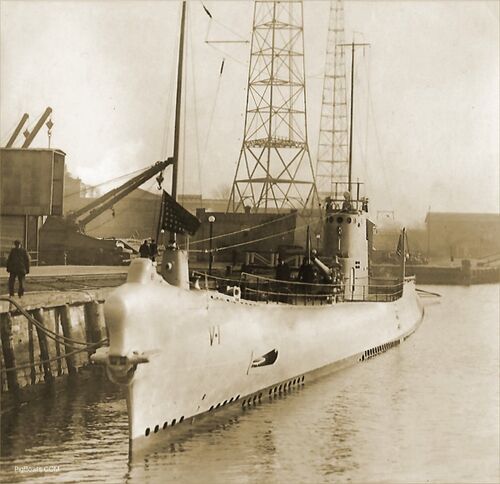
U.S. Navy photo

Photo courtesy of Ron Martini

All three of her radio masts are lowered, indicating that she has just surfaced or is preparing to dive, although either maneuver would be dangerous this close to land.
National Archives photo
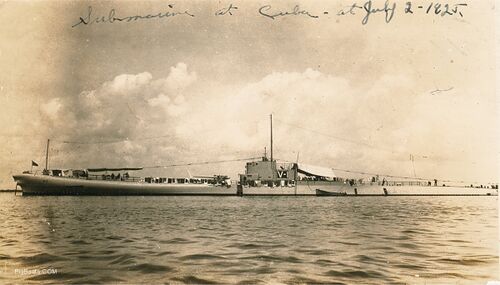
One of the two ship's boats, stowed under the deck just aft of the conning tower fairwater when not in use, can be seen moored alongside. Forward of the conning tower can be seen a folding set of steps to allow access to the submarine from a small boat. These were folded back into the superstructure when not needed.
Photo in the private collection of Ric Hedman.
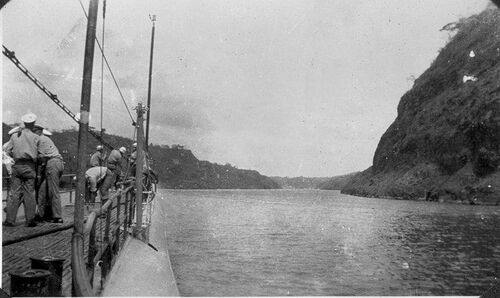
Photo in the private collection of Ric Hedman.
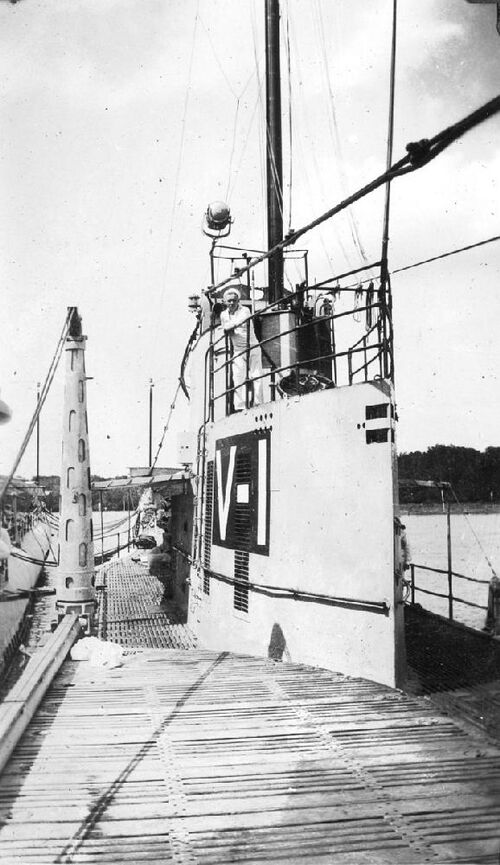
Photo in the private collection of Ric Hedman.

Photo in the private collection of Ric Hedman.
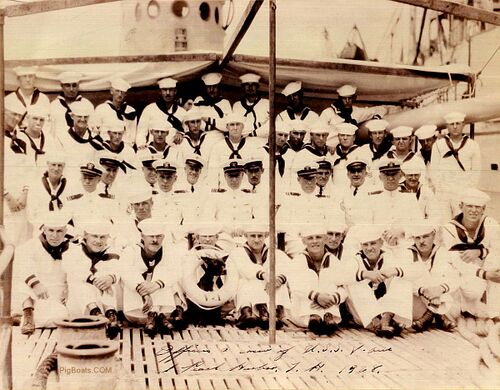
In the photo the fourth man from the left, second row from the top, is Herman S. 'Brigham' Young, grandfather of Johanna Young who submitted this photo.
The barrel of the V-1's 5"/51 caliber deck gun is pointed to the right in the photo to make room for all the men to be positioned at the widest point on the deck. The top man on the right is leaning on the barrel.
Original photo in the family collection of Johanna Young. MAY NOT BE REUSED OR REPOSTED WITHOUT PERMISSION.
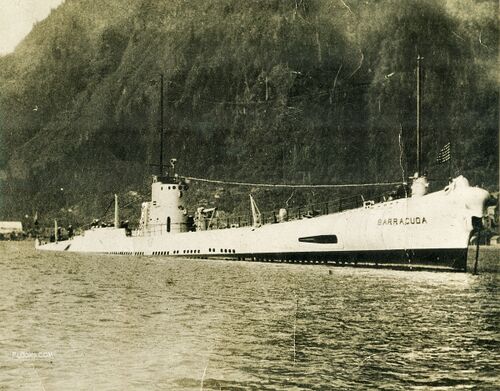
Photo in the private collection of Ric Hedman.

Photo in the private collection of Ric Hedman.
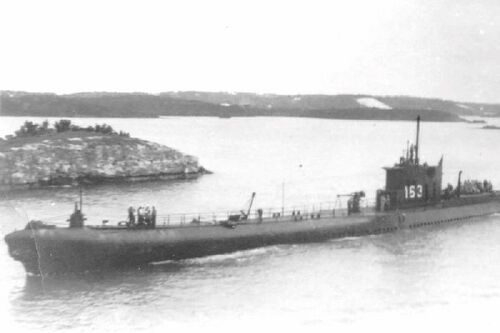
U.S. Navy photo
Page created by:
Ric Hedman & David Johnston
1999 - 2023 - PigBoats.COM©
Mountlake Terrace, WA, Norfolk, VA
webmaster at pigboats dot com
